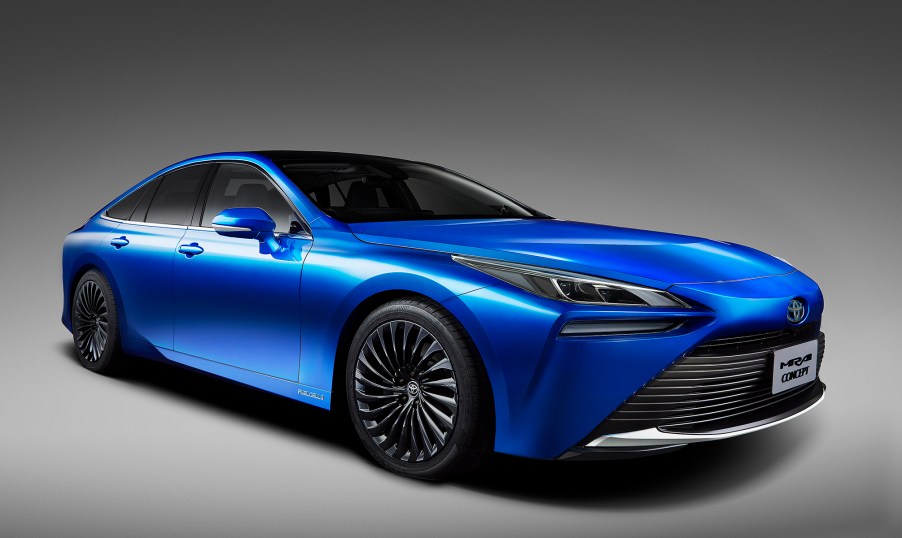
The 2021 Toyota Mirai Gives Us a Glimpse Into an Alternate Future
The hype surrounding electric vehicles has become undeniable at this point. From SUVs from Tesla to pickup trucks from GMC. However, the popularized EV isn’t the only option available. This is where the 2021 Toyota Mirai comes in with its hydrogen fuel cell electric powertrain. For 2021 CarBuzz reports that the unusual Toyota gets up to 400 miles of range.
What is a Toyota Mirai?

While the Prius gets most of the spotlight, the Toyota Mirai is pushing some serious efficiency innovation. Introduced originally in 2014, the hydrogen fuel-cell Mirai didn’t exactly sell in high quantities. Aside from needing hydrogen to power its electric motor, CarBuzz report that it was only sold in small quantities in California and Hawaii.
To spice up the Mirai, Toyota moved it away from looking like a Prius and more toward a luxury sedan. CarBuzz report that the 2021 model now rides on the TNGA-L platform. This underpins large Lexus models such as the LS and LC 500. Since there is no traditional engine under the hood, all of the powertrain components can be neatly stacked together, providing much greater interior space.
Just because it’s got sporty looks, don’t expect the Toyota Mirai to be a sporty performer. For 2021, the Mira develops 179 hp and 221 lb-ft of torque. When you factor those figures into a large body style, you get a 0-60 time of 9.2 seconds, says CarBuzz. However, the Mirai is about much more.
Here’s what makes it different

Although an electric motor powers the Toyota Mirai, the process is completely different from that of a “traditional” electric vehicle. According to Green Car Reports, the electricity that powers an EV is harvested, then transported via an electrical grid, to finally stored in the battery pack. In contrast, the energy that powers the Mirai has to be harvested, go through electrolysis, compressions, and liquefaction. From there, it’s transported to hydrogen fuel stations where you can fill up. The onboard generator then creates the electricity for the battery pack.
Once the Toyota Mirai’s battery pack is topped up, it acts like any other EV, sending the electricity to an electric motor. However, the main difference is that most of the energy initially harvested doesn’t actually make it to the electric motor. According to Green Car Reports, an EV loses about 8 percent of electricity throughout the entire process. In contrast, only 25 to 35 percent of the original energy makes it to a hydrogen vehicle’s electric engine. The result is that the electric vehicle is far more efficient.
Will we all drive fuel-cell vehicles in the future?

As it stands, the Toyota Mirai has to fight an uphill battle. While EVs have an ever-growing number of available charging stations across the U.S., hydrogen filling stations are much harder to come by. According to Convenience, there are around 48 hydrogen filling stations as of early 2020. 43 of those are available exclusively in California. The result is that even if you want a Mirai, you’ll have to live in these select locations.
There’s also the issue of price. While EVs have slowly become more affordable, the Toyota Mirai is not. According to CarBuzz, the 2021 Mirai has a base price of just under $50,000, making it quite expensive. For now, it seems a hydrogen-powered future is still quite far away.


